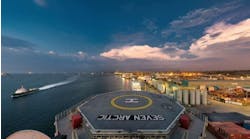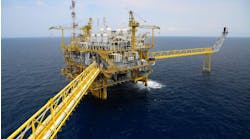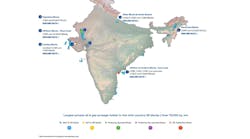The MAC manifold was developed by DSND Consub in a cooperation agreement with the Brazilian oil company Petrobras. The first phase of the installation of the subsea production manifold (MAC) has been successfully concluded. The manifold is already producing from two connected wells offshore Brazil at the Enchova Oeste Field Development.
The multiplex control systems and shared actuation control (SAC), in Phase 2 of the project, was installed in March. The entire diverless intervention concept and its associated control system, removes the need for large and expensive actuated valves and complex feedback systems.
The aim of the project was to design a much lighter and smaller manifold, with greater reliability than conventional structures, while also reducing the costs of installation, operation, and maintenance. The design requires the use of diverless intervention techniques, so that control pod replacement and valve operation can be accomplished by an ROV (remotely operated vehicle).
The key to the design is the use of a retrievable valve actuation robot (SAC) which locates onto a mating valve interface structure (VIS) and operates manual valves on the manifold. The manual valves are positioned on the manifold such that their operating shafts are coupled to standard rotary torque tool interfaces in two parallel rows at the VIS. The SAC is lowered onto two guideposts on the VIS and locked in place by ROV without the need for guide wires.
Manual valve actuation
The SAC consists of a structural protection frame which houses the tool positioning module and control system. The tool positioning module consists of a rail spanning the length of the SAC onto which the carriage assembly is mounted. The carriage assembly has two "arms," each fitted with torque tools suspended directly over the rows of valve interfaces. The tools can be independently lowered into the valve interface receptacles in order to operate the production valves. The system and the design allows for compliance to accommodate misalignment.
In addition, the design allows for valve operation using a standard ROV deployed torque tool when the SAC is removed from the manifold. All positional references are computed from flow sensors in the hydraulic system, to avoid the fitting of electrical/electronic sensors to the tool carriage. It also alleviates the need for underwater lights and cameras, further simplifying the system.
As a subcontractor to DSND Consub, Halliburton SubSea built valve position indicators (VPI) that are fitted to the torque tool interface of each valve on the VIS so that valve status can be visually verified by ROV.
Testing
In order to prove the viability and operability of the system, a working prototype SAC was made. Following extensive factory testing, the unit was mated with a dummy manifold in Brazil and installed in shallow water for accelerated lifetime tests. The SAC was successfully functioned for an equivalent of five years of operation, with continual logging of the control system data.
The MAC Manifold is designed to have a 20-year life span. While the SAC is recoverable for maintenance, it has been designed to operate continually for five years without the need for recovery. This requirement has lead to manufacture of the entire system - robot, rail, and all fittings and fixtures - being manufactured from titanium, a material chosen for strength, lightness, and resistance to corrosion.
The torque tools are also assembled from predominantly titanium components, with the main bodies and valve stem sockets being coated with titanium nitride to give a hard wearing finish. The remaining titanium components are anodized to protect any less noble metal around them from galvanic corrosion. Oil filled components, such as the VPI and torque tools, are filled with high viscosity, extreme pressure transmission fluids for enclosed systems. These fluids were specifically chosen as their oil additives do not attack the copper based alloys inside the units.
Versatility
While the MAC Manifold System was designed around a total of eight wellheads, based on a total of 48 control valves incorporated into the manifold, the system is versatile and can be designed for manifolds of any size. The MAC manifold is intended for deployment in shallow water as the Enchova Oeste Field Development is located in only 100 meters water depth. However, the SAC has been designed for operation in 2000 meters water depth, providing Petrobras with the opportunity to use it on a number of other new field developments offshore Brazil. The system can be adapted to greater depths as required.
The MAC concept should offer significant capex savings, but opex costs also will be reduced over its design life, as it will offer increased reliability against other existing designs and concepts.


